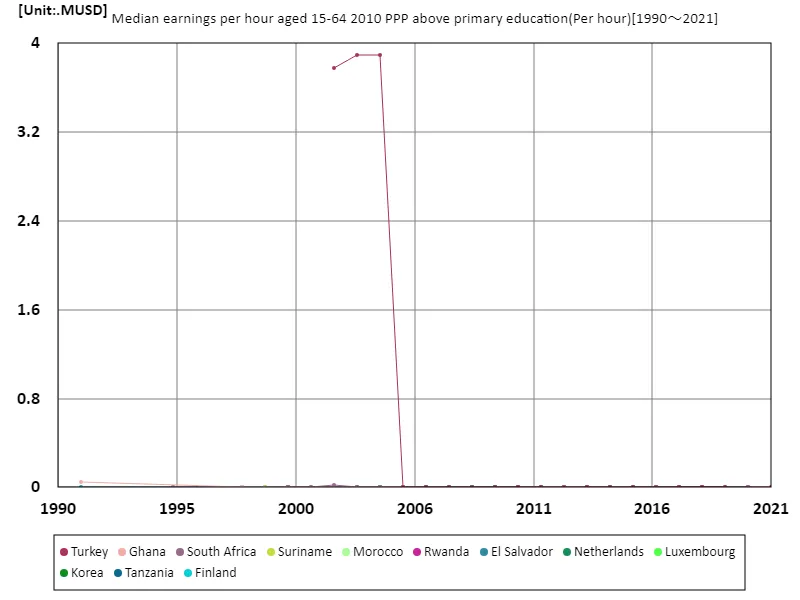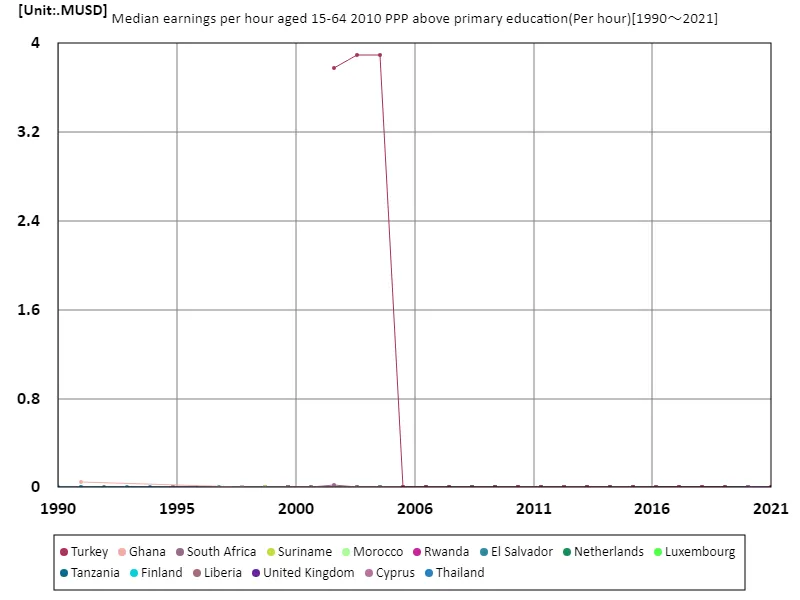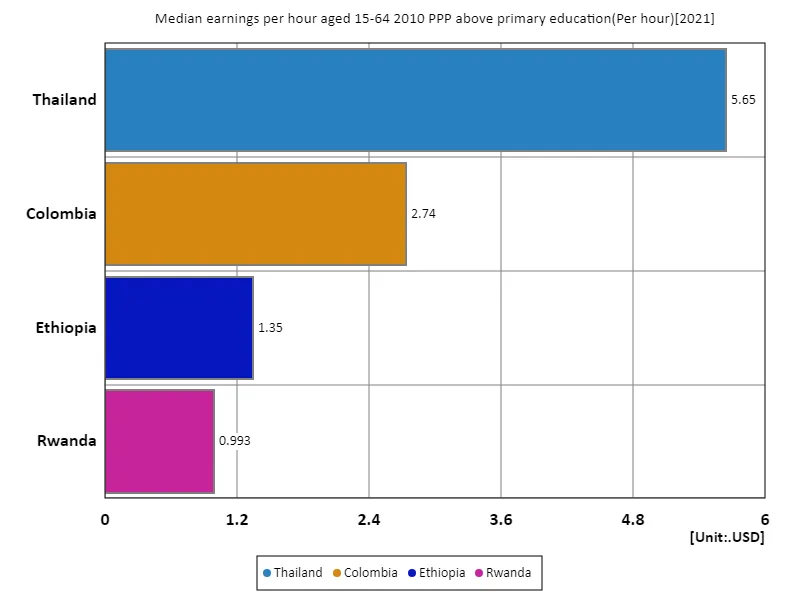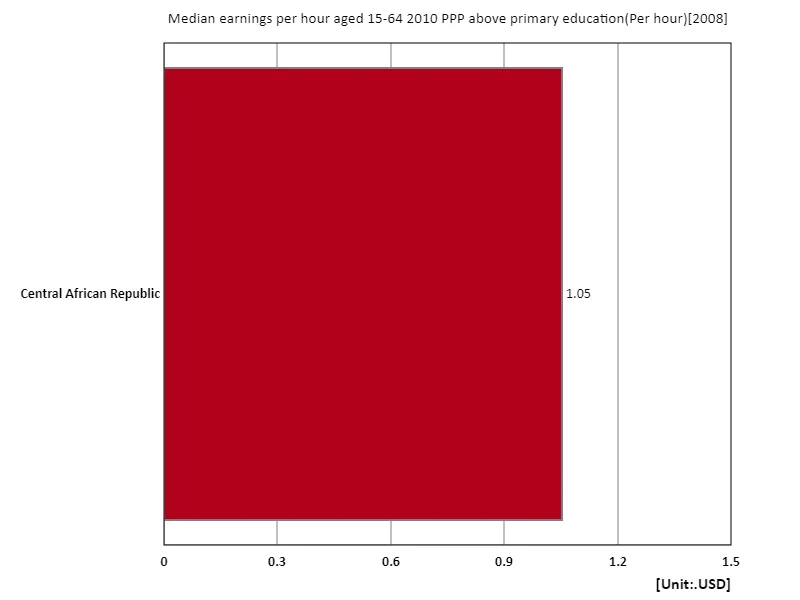- Abstract
- Average hourly wage (secondary education or above, 15-64 years old, 2010 purchasing power parity)
- Average hourly wage (secondary education or above, 15-64 years old, 2010 purchasing power parity) (worldwide)
- Average hourly wage (secondary education or above, 15-64 years old, 2010 purchasing power parity) (nations around the world, latest year)
- Average hourly wage (secondary education or above, 15-64 years old, 2010 purchasing power parity) (region, latest year)
- Reference
Abstract
Employment underemployment is an important indicator that reflects the health of the economy and the dynamics of the labor market. According to 2021 data, Moldova recorded the highest rate of underemployment among its working-age population aged 15-64 with at least secondary education, at 13.2%, working less than 35 hours a week. This trend suggests economic instability, a lack of employment opportunities, and a job mismatch, especially for young people with higher education. As is the case in many countries, the higher the level of education, the wider the gap between job expectations and actual employment conditions tends to be, which can lead to social discontent and economic insecurity. The case of Moldova shows that economic recovery and growth requires creating decent employment opportunities, especially for a highly educated workforce.
Average hourly wage (secondary education or above, 15-64 years old, 2010 purchasing power parity)
Average hourly wage data from 1991 to 2021 highlights the changing economic environment and labor markets around the world. In particular, Turkey’s 3.9 MUD recorded in 2004 was a peak indicating economic growth and a revitalized labor market. However, subsequent data shows that the average hourly wage in Turkey has fallen by 130% – likely due to economic instability, inflation and political factors. During this period, wage growth slowed in developed countries, while emerging countries saw their labor markets develop and wages tend to rise. There is a growing demand for workers, especially those with secondary education or higher, making education and skills more important. However, in some countries, economic growth is not necessarily reflected in wages, and issues regarding wage gaps and job quality remain. Overall, trends in hourly wages reflect each country’s economic policies and labor market conditions, and are an important indicator for considering future sustainable growth.


The maximum is 3.9MUSD[2004] of Turkey, and the current value is about 130μ%
Average hourly wage (secondary education or above, 15-64 years old, 2010 purchasing power parity) (worldwide)
The data from 1991 to 2021 reflects each country’s economic situation through fluctuations in average hourly wages. Turkey’s record of 3.9 MUD in 2004 symbolized rapid economic growth, but its subsequent decline of 130% indicates the impact of economic instability, inflation and political factors. Such changes are observed not only in Türkiye but in many other countries. While wage growth has tended to slow in developed countries, emerging countries are seeing an increase in demand for workers with secondary education or higher, and wages are often rising. As education and skills become more important, structural changes in the labor market are having a significant impact on wages, with demand for skilled jobs in particular increasing. However, in many cases, economic growth does not necessarily translate into increased wages, and wage gaps and job quality remain issues. Trends in average hourly wages are an important indicator when considering future sustainable economic growth.


The maximum is 3.9MUSD[2004] of Turkey, and the current value is about 130μ%
Average hourly wage (secondary education or above, 15-64 years old, 2010 purchasing power parity) (nations around the world, latest year)
According to 2021 data, the average hourly wage is 2.68 USD, with the highest being Thailand’s 5.65 USD, for a total of 10.7 USD. This figure reflects the diversity and imbalances in labor markets across the world’s economies. As Thailand shows, economic growth in certain countries has a positive impact on workers’ wages, with developments in tourism and manufacturing contributing to higher wages. However, the average hourly wage of $2.68 remains low in many countries, with education and skills shortages affecting wages, especially in developing countries. This trend shows that economic growth does not necessarily translate into higher wages. We are also entering an era where skills upgrading is required as the demand for educated workers increases. Furthermore, in some countries and regions, economic disparities are widening and labor market fluidity is declining. Improving education and improving skills will be key in future policy formulation and will serve as the foundation for achieving sustainable economic growth. Fluctuations in average hourly wages are an essential indicator for understanding each country’s economic situation.


The maximum is 5.65USD of Thailand, the average is 2.68USD, and the total is 10.7USD
Average hourly wage (secondary education or above, 15-64 years old, 2010 purchasing power parity) (region, latest year)
Based on 2008 data, an average hourly wage of USD 1.05 reflects the harsh reality of the labor market, especially in developing countries. The Central African Republic has the highest rate, highlighting economic hardship, lack of infrastructure and limited educational opportunities. This level directly reflects the living standards of workers and is a contributing factor in increasing poverty and social inequality. In addition, low hourly wages mean that education and skills are not improving sufficiently, and there is particular concern that demand for workers with secondary education or higher is low. Globally, while the importance of education is increasing, workers continue to be unable to meet the skills demands of the labor market. This data suggests that countries urgently need to improve their economic policies and social welfare. In order to achieve sustainable growth, it is essential to reform the education system and implement measures to increase the flexibility of the labor market. Overall, stagnant average hourly wages will be key to overcoming countries’ economic challenges.


The maximum is 1.05USD of Central African Republic, the average is 1.05USD, and the total is 1.05USD



Comments